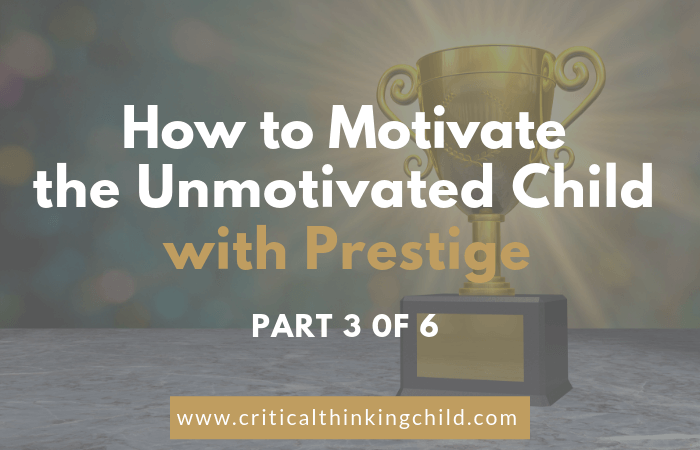Throughout this series, we’ve touched on how daunting it can be to motivate your child, especially when they show little interest in the topic at hand. Often, we want our children to be intrinsically motivated to do their best – but that isn’t the reality. Instead, your child may be motivated to take action and try their best by something external.
Students attuned to prestige are particularly in need of extrinsic motivation. Even verbal praise is not enough for these children; they thrive when they receive public recognition or awards.
What is prestige?
Prestige is closely related to two other motivational strategies: praise and prizes. The big difference is that students motivated by prestige respond to public recognition of their accomplishments. Where those motivated by praise or prizes may be content with a quiet recognition or a prize slipped into a backpack, those motivated by prestige need more. This might come in the form of receiving a certificate or award in front of their peers, or even just having the classroom floor for a couple of minutes to share what they can do.
Who is motivated by prestige?
Recognition-driven or status-oriented children are particularly motivated by prestige. You might notice these tendencies in your children when they immediately rush to show you their work or soak up the spotlight in performances or academic contests like spelling bees.
Children with a strong desire to be seen and acknowledged, or who enjoy feeling in control of situations, may also respond well to prestige. Additionally, if your child displays aggressive behavior, prestige can often mitigate it. Often, aggression is simply a form of seeking control. It isn’t always a bad thing; it shows that your child is passionate about something, which can be channeled into positive avenues. Prestige allows them to showcase their abilities, receive immediate public feedback, and feel both seen and heard.
It’s worth noting that while some students are highly motivated by prestige, others shrink back at the idea of public recognition. It’s important to pay close attention to how your child responds to this form of motivation. Do they enjoy the spotlight? Or does it embarrass them and actually make them less motivated? If you’re new to trying prestige, take careful note of how your child responds.
How do I use prestige to motivate my child?
First, prestige can take on a variety of forms that aren’t difficult to implement at home. Try rewarding your child with a physical sticker or gold star your child can wear to show off their achievements, or give them a certificate or ribbon that they can put up on their wall at home.
Second, it can also come in the form of an award. Even if your child doesn’t “win”, you can get present them with awards based on their performance. Think “most improved speller” or “solved a new math problem.” This allows you to take the focus off of winning and instead put it on acts of improvement, effort, and practice. This helps students become comfortable with taking risks and recognizing small gains over time.
Last, prestige can also be used without a physical reward – in fact, time may be the greatest reward for these children. Teachers can allow prestige-motivated students to share their work with the class for five minutes, for example. Parents can highlight their child’s recent achievements on a video call with grandparents. If you’re the parent of a prestige-motivated child, you can give them the opportunity to share their personal wins with friends or family members. Anything that puts the children in the spotlight for their hard work is fair game!
Why does prestige work?
Prestige can be an effective motivator because it allows your child to feel important and recognized by their peers and the adults in their lives. Prestige is an exclusively extrinsic motivator, meaning that students get something tangible and visible for their work rather than having to rely only on intrinsic motivation to achieve.
Prestige is also effective because it prevents negative attention-seeking behaviors by replacing them with acknowledgement for positive behaviors and achievements. Who doesn’t want to be seen and recognized for a job well done? If children are appreciated for what they are doing right, they are much less likely to do something wrong.



